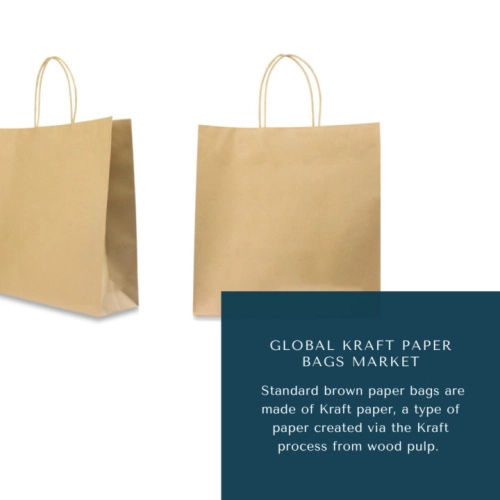
- Get in Touch with Us

Last Updated: Apr 25, 2025 | Study Period: 2024-2030
Standard brown paper bags are made of Kraft paper, a type of paper created via the Kraft process from wood pulp. Because brown Kraft paper is not bleached, it is biodegradable, compostable, and recyclable, making it a triple threat! It makes sense why they're a fantastic alternative to plastic.

While bleached kraft paper is white, natural or unbleached kraft paper is a light brown tone. When maximal strength is required, such as in industrial bags, grocery bags, inner plies of multiwall sacks, or plain wrapping paper, natural kraft paper the strongest of the main packaging papers is employed.
Corrugated board liners are also made from kraft fibers. The strongest white paper is bleached kraft paper. It is used for things like flour and sugar sacks, labels, and envelopes when strength, printability, and attractiveness are crucial.
The global kraft paper bags market accounted for $XX Billion in 2023 and is anticipated to reach $XX Billion by 2030, registering a CAGR of XX% from 2024 to 2030.
Marspa Sacchificio Veneto Kraft paper bags are produced for industrial application. Ecological paper dustbin bags with a polythene lining are also available.
Bags with valves, open mouths, and sewing. Paper bags for the following industries: chemicals, construction, mining, food for humans and animals, and trash .
Kraft paper bags are practical with flat or twisted handles, environmentally friendly, and recyclable to carry any type of product, in different formats made from recycled and white paper. Ronpak paper packaging is made from a single, continuous roll of paper that is printed on and converted into.
They are perfect for fast food, food trucks, or really any industry that wishes to give its business a more environmentally friendly image. You will receive high-quality, resistant bags with their curled or flat handles. Rovi Packaging is firmly committed to using BIO materials that are sustainable for the environment and the final product.
| Sl no | Topic |
| 1 | Market Segmentation |
| 2 | Scope of the report |
| 3 | Abbreviations |
| 4 | Research Methodology |
| 5 | Executive Summary |
| 6 | Introduction |
| 7 | Insights from Industry stakeholders |
| 8 | Cost breakdown of Product by sub-components and average profit margin |
| 9 | Disruptive innovation in the Industry |
| 10 | Technology trends in the Industry |
| 11 | Consumer trends in the industry |
| 12 | Recent Production Milestones |
| 13 | Component Manufacturing in US, EU and China |
| 14 | COVID-19 impact on overall market |
| 15 | COVID-19 impact on Production of components |
| 16 | COVID-19 impact on Point of sale |
| 17 | Market Segmentation, Dynamics and Forecast by Geography, 2024-2030 |
| 18 | Market Segmentation, Dynamics and Forecast by Product Type, 2024-2030 |
| 19 | Market Segmentation, Dynamics and Forecast by Application, 2024-2030 |
| 20 | Market Segmentation, Dynamics and Forecast by End use, 2024-2030 |
| 21 | Product installation rate by OEM, 2023 |
| 22 | Incline/Decline in Average B-2-B selling price in past 5 years |
| 23 | Competition from substitute products |
| 24 | Gross margin and average profitability of suppliers |
| 25 | New product development in past 12 months |
| 26 | M&A in past 12 months |
| 27 | Growth strategy of leading players |
| 28 | Market share of vendors, 2023 |
| 29 | Company Profiles |
| 30 | Unmet needs and opportunity for new suppliers |
| 31 | Conclusion |
| 32 | Appendix |